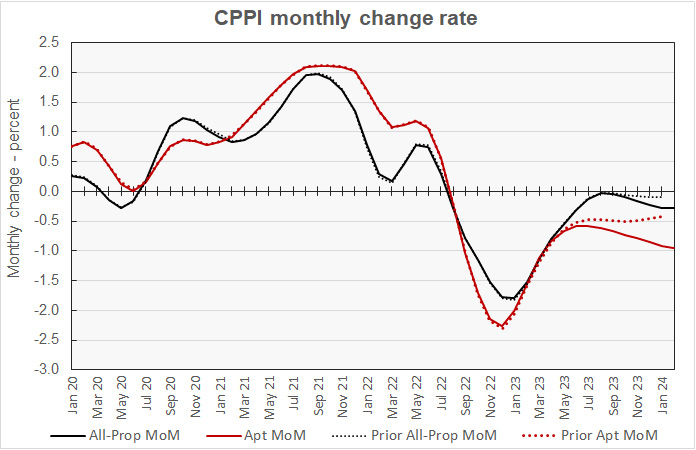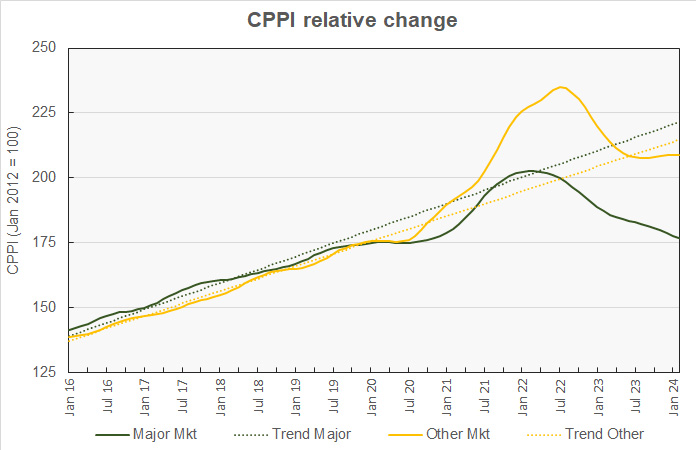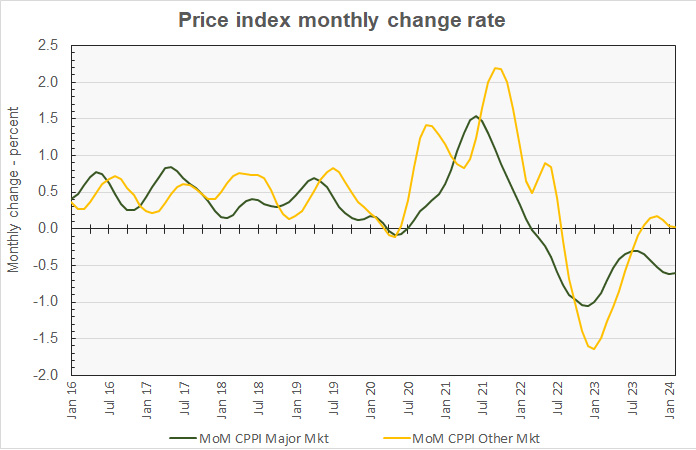The latest commercial property price report from MSCI Real Capital Analytics said that multifamily property prices fell 1.0 percent from their level of the month before in February. This is much faster than last month’s reported decline of 0.4 percent. Prices were down 8.9 percent from their level of one year before.
Defining CPPI
MSCI tracks an index called the Commercial Property Price Index (CPPI). The index is computed based on the resale prices of properties whose earlier sales prices and sales dates are known. The index represents the relative change in the price of property over time rather than its absolute price. Note that, as new properties are added to the MSCI dataset each month, they recalculate the CPPI all the way back to the beginning of the data series.
Multifamily property price growth revised lower
The first chart, below, shows how the CPPI’s for all commercial property as a single asset class and for apartments have changed since January 2016. To simplify the comparison, both CPPI’s have been normalized to values of 100 in January 2012. The chart also contains trend lines showing the straight-line average rates of price appreciation for the two asset classes based on their performances from January 2012 to December 2019.

The chart shows that multifamily property prices are continuing to fall in absolute terms. After being almost unchanged between July and October, commercial property prices in general have also resumed their decline.
Multifamily property prices have fallen 18.4 percent from their peak but are still 14.3 percent above their level in January 2020. They are also 8.5 percent below their pre-pandemic trend. Prices for all commercial property as a single asset class are down 12.2 percent from their peak but are 13.1 percent above their level in January 2020. They are 8.4 percent below their pre-pandemic trend.
The next chart plots the month-over-month changes in the values of the CPPI since January 2020 for all commercial property as a single asset class and for apartments. It also includes the same values based on the data included in last month’s report. As noted above, the CPPIs are recalculated as more data arrives and the effects of these recalculations are illustrated in the chart. Changes to the data for both property classes showed prices falling more rapidly than indicated in last month’s report, both for January and for several months before.

Industrial again leads in price growth
On a month-over-month basis, the industrial property class was the only class tracked by MSCI in which prices rose in February, with a gain of 0.2 percent. The retail property class saw prices remain unchanged for the month. Prices for office properties within central business districts (CBDs) fell 1.3 percent for the month while prices for suburban offices fell by 0.4 percent.
Industrial property was also the best performing class on a year-over-year basis, managing a gain of 1.9 percent. Prices for offices within CBDs were down 29.9 percent while prices for suburban offices fell 11.6 percent. Prices for retail property were down 2.5 percent.
Major metro commercial property prices lag
The MSCI report provides data comparing the price changes of commercial property in 6 major metro* areas against those in the rest of the country, although it does not separate out multifamily property prices from those of other commercial property types in this comparison. The next chart, below, plots the history of the relative price indexes since January 2016 for both market segments, along with trend lines based on straight-line fits to the changes in these indexes between January 2012 and December 2019. For purposes of this chart, both price indexes were set to a value of 100 for January 2012.

The chart shows that the CPPI for major metro commercial property has fallen 12.8 percent from its peak and is now only 1.0 percent above its level in January 2020. It is 20.3 percent below its long-term trend. By contrast, the CPPI for property in other markets has fallen 11.1 percent from its peak and is still 19.6 percent above its level in January 2020. The non-major metro CPPI is 2.8 percent below trend.
The final chart plots the history of the month-over-month changes in the price indexes for the two property markets since January 2016. The chart shows that month-over-month price appreciation for major markets has been around -0.6 percent for the last 3 months. The chart also shows that price appreciation for the other metros has been positive, if only marginally so, for the last 6 months.

By the numbers, price appreciation for commercial property in major metros was reported to be -0.6 percent for the month and -5.6 percent for the year. Price appreciation for commercial property in non-major markets was reported to be +0.02 percent month-over-month and -3.6 percent year-over-year.
The full report provides more detail on other commercial property types. Access to the MSCI report can be obtained here.
*The major metros are Boston, Chicago, Los Angeles, New York, San Francisco and Washington DC.












